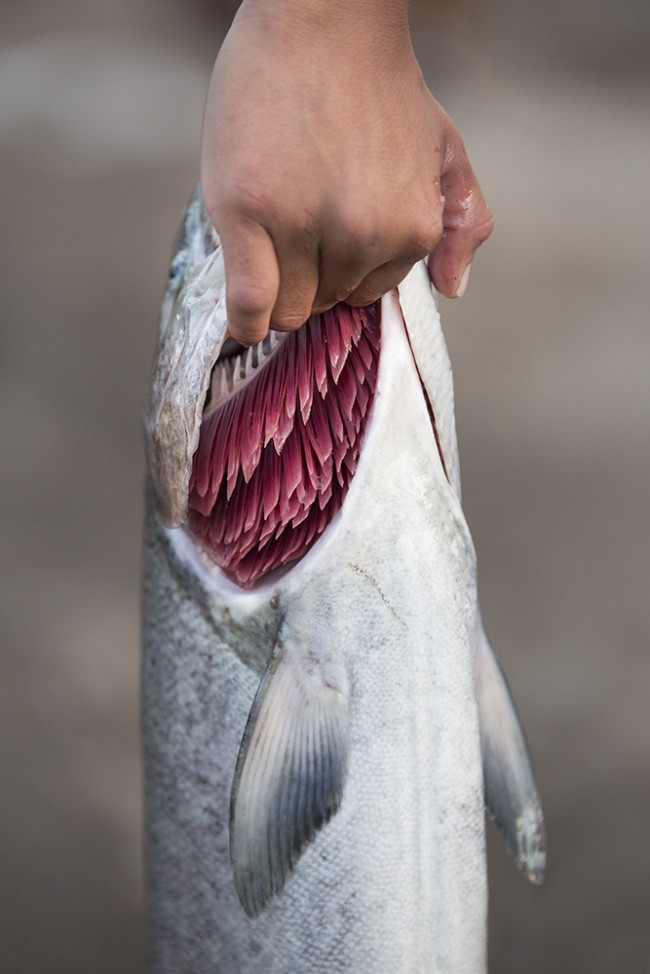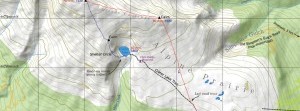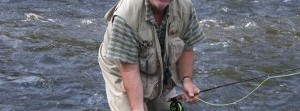
Photo Credit: Marty Clemens
The Last Salmon Stronghold
Salmon are the lifeblood of the Skeena. Elite athletes of natural engineering, travelling thousands of kilometres throughout the Pacific Ocean, only to swim back to whence they came, spawn and die. People from around the world f lock to the banks of the Skeena River, one of the final strongholds of salmon, just for a glimpse of a creature synonymous with wild landscapes.
For those of us lucky enough to live here, salmon are a way of life. The fish bring people together, to break bread and build community. Salmon have sustained life here for thousands of years and are our most precious and valuable resource. As long as wild salmon swim these rivers, we will survive.
Perhaps that’s why this season’s closure of sockeye and Chinook fisheries along the Skeena River and its tributaries was such a shock and has many sounding the alarm after years of dwindling returns.
Sockeye stocks
It was a rough start to the year. After months of speculation, the Department of Fisheries and Oceans (DFO) projected the sockeye run to be around 500,000. When the fish count began in the spring, projections dipped even lower, to around the 400,000 mark.
DFO and several First Nations along the Skeena decided the only option was to ban the harvest of sockeye for all recreational, commercial and Indigenous harvesting. The average number of wild sockeye returning to the Skeena (not including those returning to artificial spawning channels near Lake Babine) have declined by 27 percent over the last decade, according to information gathered by the Pacific Salmon Foundation.
There are too many contributing factors at play to put the blame on any one issue, be it climate change, high ocean mortality rates, or overfishing. But one thing is clear: the dwindling runs have a lot of people worried and wondering if low returns will soon become the norm.
Salmon are a cyclical species. Typically, every four years we should see smaller than average returns. In 2013, according to DFO scientists, a large mass of high-temperature water circling the Pacific Ocean could have been a major contributor to the poor sockeye run that year. With higher predation rates (warmer waters attract more predators) and a low brood year in 2013, this season’s low returns start to make sense.
Culture and community
For many in northern BC, fishing is as important as breathing. Some would even say it’s in our DNA, part of our identity. And the impacts of declining salmon populations on our culture and communities are already being felt. Chief Na’Moks of the Witsuwit’en, an upstream nation that relies on salmon for ceremonial and sustenance purposes, vital to the retention of their culture, says he’s never seen such low sockeye numbers.
“I didn’t have the opportunity to have my family come and work together in our smokehouse as we do every year,” Na’Moks says. “That time we spend with each other, to reminisce and remind ourselves of our stories, to teach our young ones. Our history is oral and we didn’t get that time at all this year. If we don’t take responsibility for our actions this will become common.”
When DFO announced the ban on June 15, the day before fishing season was set to open on the Skeena, Jodi Smith was crushed.
“I don’t think there are any words; it’s heartbreaking,” says Smith, an avid angler from the Bulkley Valley. “This is what it’s coming to, and it seems to be happening everywhere.” Usually she would head out to the river with her kids the first chance she got. Holidays were planned around when the river would be open, but it was tough to nail down because the regulations on where you can and cannot fish were confusing, according to Smith.
“A lot of people I know got a fine for things they were unaware of. I think it’s important to keep more lures out of the water to allow the salmon to spawn and get their numbers back up, but they have to do a better job at communicating those regulations: when and where they come into effect.”
Smith adapted to the situation by exploring more lakes and fishing for trout, noting that even when they did head to the river, they weren’t catching anything. “It just proves how low the numbers really are,” she says. “It’s just a big disappointment.”
At Oscar’s Source for Adventure, a tackle shop in Smithers, you quickly get a sense of how the small business is coping with the abnormal fishing season. In early August, a steady stream of people moved through the store. Every angler cooped up since June was finally breaking free and running to the river. But looks can be deceiving.
“What you’re seeing today was actually a lot of people getting their licenses now, versus getting them in June,” says Oscar’s owner and operator, Alex Bussmann. “People are finally thinking about fishing again.”
“For me, though, it’s more than dollars and cents,” he says. “We all have to try and work together. We’re sometimes labelled as sport fishers, but for a lot of us it’s more than just sport fishing. It’s a way of life. We have to be careful with the resource, we understand that, but the closure was pretty drastic.”
In Moricetown, Willie Pete, a Witsuwit’en fisherman, works the Moricetown Canyon for a tag and release program. Over the years Pete says he’s noticed the salmon have decreased in size and runs continue to shrink.
“I’ve been doing this for 39 years now,” he says. “Very few springs this season. I’ve caught 10 so far. We’re used to catching 55-pounders, and we’re getting little 17-pounders. We’d be lucky if we got 50 out of the canyon right now."
Many Indigenous communities along the Skeena have resorted to visiting Nisga’a territory to access healthier stocks on the Nass River. Chief Na’Moks says in his decades of harvesting fish, this was a first.
“I’ve never had to do that before; I’ve always had access to salmon. This was the first time we had to reach out to [the Nisga’a]. There was an opportunity for us to get some salmon, in particular for our elders, and we were fortunate enough to get some.”
“I’m pretty concerned about it,” says Pete. “My son and grandson will probably come down here and fish also. What’s going to be there for them in the future?”
Wild Salmon Policy
In 2005, the federal government developed the Wild Salmon Policy (WSP) as a framework and action plan to address the sustainability of wild salmon populations in Canada. The policy calls for identifying and managing wild salmon through “Conservation Units”, that reflect geographic and genetic diversity. The hope is the policy “will foster a healthy, diverse, and abundant salmon resource for future generation of Canadians.”
“The fundamentals of the WSP have been established and have been a key part of fisheries management since it was established,” says Colin Masson, DFO Director for the North Coast. “A lot has been incorporated into management approaches and thinking and actions, and yet there’s lots more that needs to be done.” Masson admits the work has been challenging, mostly due to a lack of data. But he says the policy is already influencing management decisions and the work is ongoing.
It’s a sensible policy, according to Aaron Hill, Executive Director of Watershed Watch Salmon Society. The tricky part is implementing a plan that actually has an impact on the ground. And for Hill, that isn’t happening fast enough.
“The Liberals, during their election campaign in 2015, promised to implement the recommendations of the Cohen Commission with a strong focus on implementing the Wild Salmon Policy,” says Hill. “It puts the conservation of wild salmon as a top priority. However, the implementation has really been lagging.”
Over the past two years the federal government has worked on a consultation process with First Nations and the provincial government to develop the implementation plan, projected to be released this fall. “Given DFO’s track record…it’s unlikely they’ll move fast enough to get any work done,” he says. “The bottom line is we need to assess the status of all of our salmon populations, and there will be a bunch in the red zone that require rebuilding plans, and those plans need to be implemented.”
Hill points out that a major key to success is more monitoring of salmon stocks on rivers and streams. But monitoring programs are at an all-time low. “Until there’s more monitoring, we’re going to be totally hamstrung in our ability to properly assess the status of our salmon runs and rebuild the endangered ones. Keeping as many of our salmon populations intact provides the best insurance in the face of climate change because the conditions that develop through climate change might favour any one of the populations more than another and we won’t know until we’re there, so we need them all.”
Masson says DFO has recently received “catch-up” funding from the federal government for salmon stock assessment and fisheries management, and hopes to stabilize the Charter Patrolmen Program, or “creek walkers”—locals hired by DFO to monitor waterways and count salmon.
“I doubt we will ever get back to the level of charter patrolmen that might have occurred 20-30 years ago,” he says. “That’s not a reality in the near future, but I personally recognize the value of the work that those folks do and some of the ones on the North Coast here are remarkable in their knowledge of the areas.”
A recently published study by Simon Fraser University researchers shows that the DFO is not monitoring enough spawning streams to accurately assess the health of Pacific salmon. Spawning stream monitoring provides vital information on salmon population fluctuations over time, including biological status required to guide fisheries and conservation. Without such information, fisheries may continue to see diminished catches and salmon populations without the necessary alarm bells sounded.
According to the study, over the past 10 years escapement surveys have declined by 34 percent to an all time low in 2014, when only 334 salmon-bearing streams were assessed, down from 1533 in the mid-1980s. Over a 30-year period, the report says, the annual count of spawning streams has declined by 70 percent.
“Our knowledge of salmon populations in BC is eroding rapidly,” says Michael Price, the study’s lead author. “Without increased support for annual spawning surveys, the rich legacy of population data available for BC’s coast is at serious risk of becoming irrelevant for future assessments of management and conservation status.”
Hope for Salmon
For now, the Skeena remains home to the second largest salmon run in BC. But it’s clear there is more pressure on wild salmon now than ever before.
“Having no more salmon coming up the river is just something I can’t imagine,” says Bussmann. “The rivers without salmon would be a total shame if my kids’ kids won’t be able to see fish. Angling aside, not seeing salmon coming up to do their thing would be devastating to us all. It is the last real stronghold of wild salmon and it’s pretty spectacular.”
Although Smith is still disappointed about the run this year, she supports the closures in the hopes that stocks rebound next year. “The situation is good for my children, ” she says. “They’re learning that the fish in the river have a purpose. It’s sad, but it’s humbling.”
Chief Na’Moks echoes the sentiment. “I don’t want salmon to be a memory,” he says. “I want salmon to be a f lavour. As a Witsuwit’en person, all of our stories, names, everything we do is tied to the land—the air, the water, the animals, the salmon, all of it.” He reminisces about his days as a “young one” and the stories that were told to him by his grandparents, passing down the knowledge of the land, most often around the fire in a smokehouse. Having to shelve that tradition this season because no sockeye or Chinook were available to be smoked is concerning, but Na’Moks remains optimistic that the low runs this season won’t become the norm. “I think the Northwest will remain a salmon stronghold,” he says. “We just have to remember that each one of us has to do our part. I love to see people come here to visit and see what we have. Then they get a realization—feet on the ground, a taste of the food, breathing the air—that we have something spectacular here we can no longer take for granted.”




I remember when 40 - 50 lb spring salmon were the norm. Why are not taking care of this treasure.
👤 Elizabeth Lee 🕔 Sep 14, 2017
Like Chief Na’Moks,my family and I also“I don’t want salmon to be a memory,” at any point in time!!! It is imperative that all (and I hesitate to use this term) British Colombians realize that the Salmon of B. C. are the quintessential “canary in the coal mine” What befalls these “Athletes of the Seas” befalls us all. Without a collective understanding of biodiversity and the way everything is eventual connected , we all, as a species, stand to be in peril. I guess it comes down to what wins out, greed over need? The more need for a bigger dividend the bigger the deficit we create in nature. Human kind can not survive without recognizing the boundaries set by Mother Nature and best practices. If Mankind can find a way to protect the salmon, he may “and just may” be able to protect our future. My thanks to Chief Na’Moks, Northworld Magizine and Dan Mesec for keeping such an important topic front and center.
👤 David McRae 🕔 Sep 16, 2017